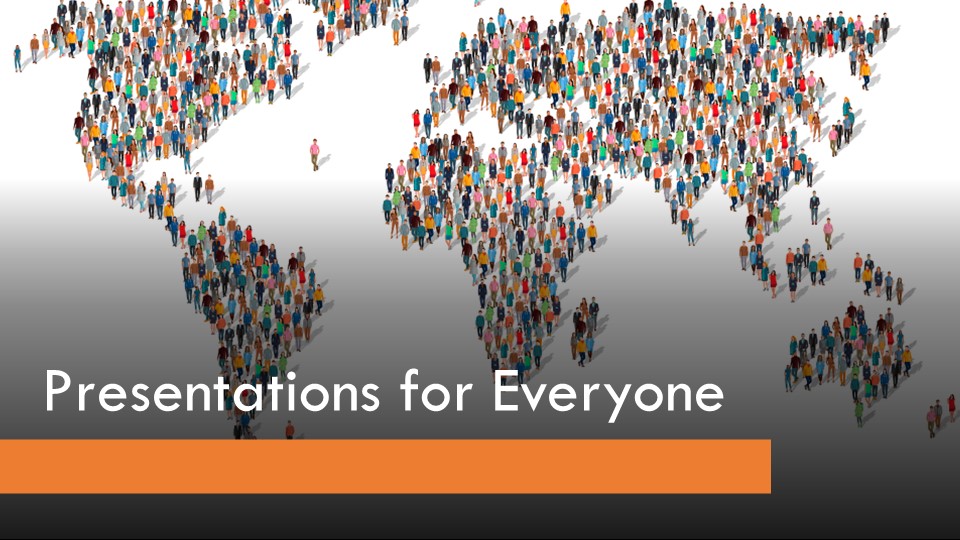
In its purest sense, a presentation is the act of making information publicly available. Today, the world is the audience and electronic presentations are the delivery vehicle. A simple web search for "online presentations" lists over 104,000,000 results. Technology has become the presenter and the presentation.
The appeal is easy to see. Companies can save thousands of dollars on travel costs. Your presentation, sales pitch, and training course can be available 24 hours a day, 7 days a week. Anyone can create a presentation or training course. The downside is that not everyone may be able to access it.
In the previous post of this series, I explained why accessibility matters. In this post, I will address what accessibility means for presentations and how to incorporate it into your process.
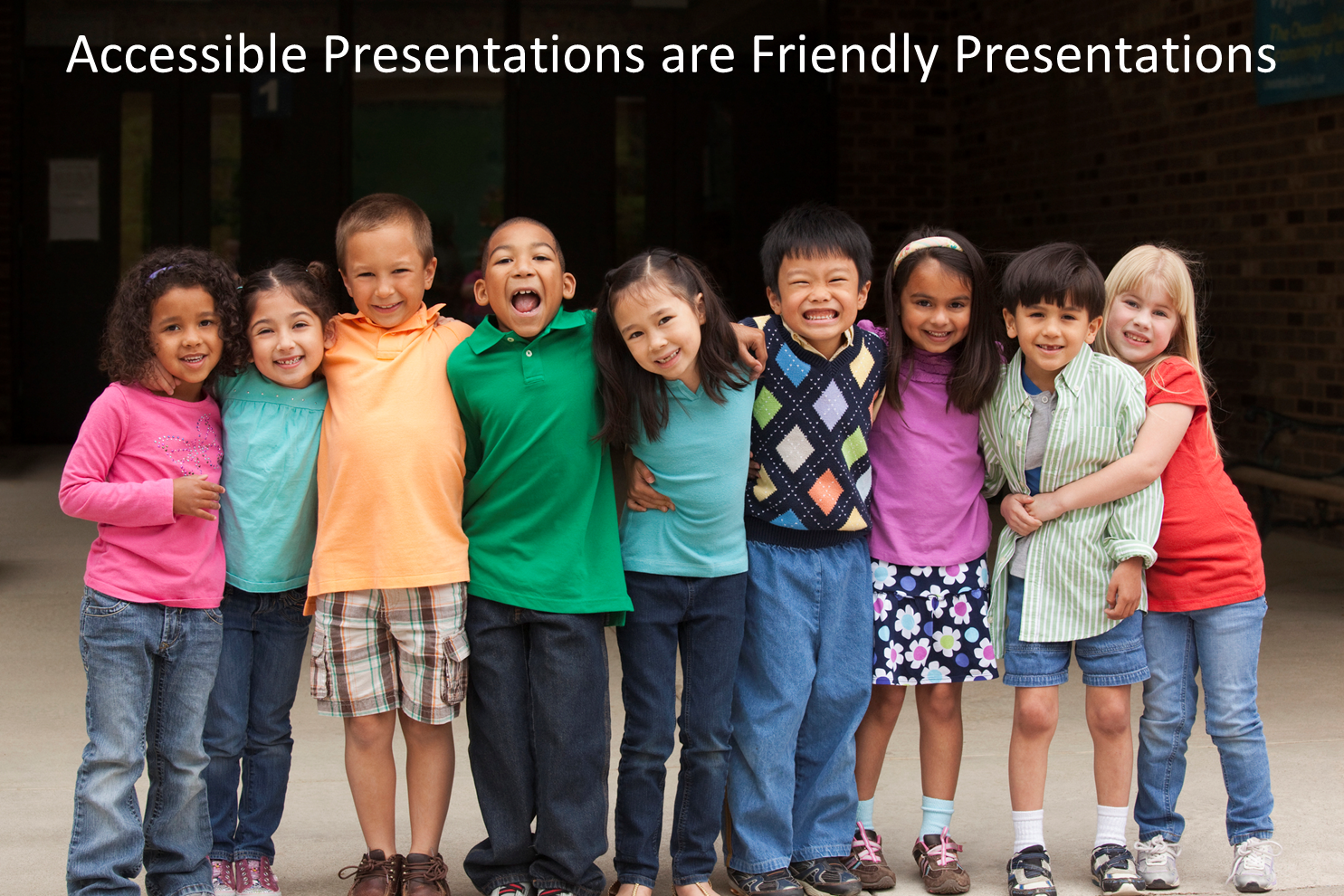
Defining Accessibility
Each of these definitions can be a goal for accessibility. My personal favorite is number four: easy to get along with and friendly.
- Capable of being reached; "a town accessible by rail"
- Capable of being read with comprehension; "readily accessible to the nonprofessional reader"; "the tales seem more accessible than his more difficult novels"
- Easily obtained; "most students now have computers accessible"; "accessible money"
- Easy to get along with or talk to; friendly; "an accessible and genial person"
Although there are definitive guidelines, at its heart, accessibility is about making presentations easy to get, easy to use, and easy to understand.
- Comprehensibility involves making sure that the language and subject matter used in a presentation is understandable by its audience, spelling and grammar are correct, and content is inclusive and not offensive. It also involves ensuring that slides can be viewed properly, regardless of the software or device used by the audience.
- Usability means that the presentation offers a convenient and efficient viewing experience to the audience and allows them to achieve the primary goal for which they are viewing the presentation in the first place. This is most likely to access a particular piece of information. It also means that the presentation can be easily traversed, the viewer is aware of where they are and how they got there, and information is organized according to a logical system that the audience can follow.
- Obtainability means the presentation can be easily found and acquired. The presentation is of a size and location that the audience can search for and get the presentation without undue difficulty.
Accessibility is really about ease of ability. Your presentations should be friendly to everyone.
Understanding Functional Limitations
The National Center for Health Statistics defines six domains of functioning, Visibility, Audibility, Comprehensibility, Mobility, Communicability, and Self-Care. Assistive/Adaptive Technology is innovative software and hardware that provide solutions in these areas.
Visibility – Visual impairments include low vision, color blindness, and blindness. People who are blind cannot use a computer monitor and must receive information from their computers via another sense – hearing or touch. People with low vision can also receive information through sound or touch, or they can modify their computer displays so the screen is more legible.
Audibility – Hearing impairments encompass a range of conditions-from slight hearing loss to deafness. People who have hearing impairments might be able to hear some sound but might not be able to distinguish words. People with this type of hearing impairment can use an amplifying device to provide functional hearing. Other people might not be able to hear sound at all. People who have hearing impairments need closed captioning for multimedia and/or narration.
Comprehensibility/Neurodiversity – Learning impairments can range from conditions such as dyslexia and attention deficit disorder to retardation. Processing problems are the most common and have the most impact on a person's ability to use computer applications. These conditions interfere with the learning process. Many people with these impairments are perfectly capable of learning if information is presented to them in a form and at a pace that is appropriate to them individually. During the learning process, many individuals with learning difficulties benefit from having a multi-sensory experience of audio speech paired with a visual representation.
Mobility – Mobility impairments can be caused by a wide range of common illnesses and accidents such as arthritis, stroke, cerebral palsy, Parkinson's disease, multiple sclerosis, loss of limbs or digits, spinal cord injuries, and repetitive stress injury, among others. As a result of these accidents or conditions, individuals might be unable to use (or be without) arms or fingers to interact with their computers using the standard keyboard or mouse.
Communicability – Language impairments include conditions such as aphasia (loss or impairment of the power to use or comprehend words, often because of brain damage), delayed speech (a symptom of cognitive impairment), and other conditions resulting in difficulties remembering, solving problems, or perceiving sensory information. For people who have these impairments, complex or inconsistent visual displays or word choices can make using computers more difficult. This category can include persons for whom English is a second language.
Self-Care – Self-Care impairments can limit the ability to perform or complete activities of daily living for oneself, such as feeding, dressing, bathing, toileting. Activities of daily living or ADLs are defined as “the stuff we regularly do such as feeding ourselves, bathing, dressing, grooming, work, homemaking, and leisure. Although self-care is not usually an area needing consideration for presentations there are some exceptions such as visual schedules used to help people with autism or dementia with self-care.
Start with Accessibility Awareness
Just by reading this article you are halfway to creating accessible and inclusive presentations. We may not think of making presentations accessible simply because it does not affect us. But as members of an inclusive society, we have a responsibility to avoid discrimination, even if it is unintentional. And (as I explained in the previous post) because of the Curb Cut Effect, we know that when we design for accessibility, we make things better for everyone in the process.
As easy method to maintain Accessibility Awareness is to mount posters in your workspace as visual reminders. You can make your own, use one or more of the three posters included in this post, or a combination of the two.
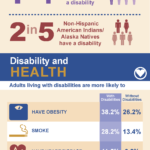
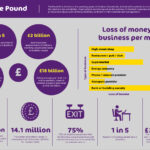
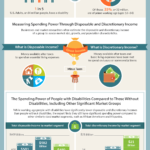
Incorporating General Principles of Inclusivity
As you design your presentation, four general guidelines will help you start to integrate accessibility and inclusivity into your work process.
- Identify Your Target Audience
- What language(s) does your audience use?
- Do any of your audience members have known assistive requirements?
- What software and devices will your audience be using?
- What type of connectivity do the members of your audience use?
- Make Your Presentation Easy to Understand
- Is it in a language that is understandable by your audience?
- Is the subject matter understandable to your audience?
- Is the spelling and grammar correct?
- Is it free of offensive content?
- Is the content inclusive or exclusive?
- Can slides be displayed properly, regardless of the software or device being used by the audience?
- Make Your Presentation Easy to Use
- Does it offer a convenient and efficient viewing experience to the audience and allow them to achieve the primary goal for which they are viewing the presentation in the first place?
- Can it be easily traversed, with the viewer always aware of where they are and how they got there?
- Is the information organized according to a logical system that viewers can follow?
- Make Your Presentation Easy to Get
- Can the presentation be easily found?
- Can the presentation be easily opened and/or downloaded?
Accessibility Is About Ability Not Disability
Accessibility is a celebration of diversity. Everyone has limitations and everyone gains from assistive technology. Accessibility is also about respect for others' abilities. British Physicist Stephen Hawking revolutionized concepts of the universe and time, despite having severe mobility limitations.
For the next post in this series, I will cover the specifics for designing presentations for people using adaptive technologies.